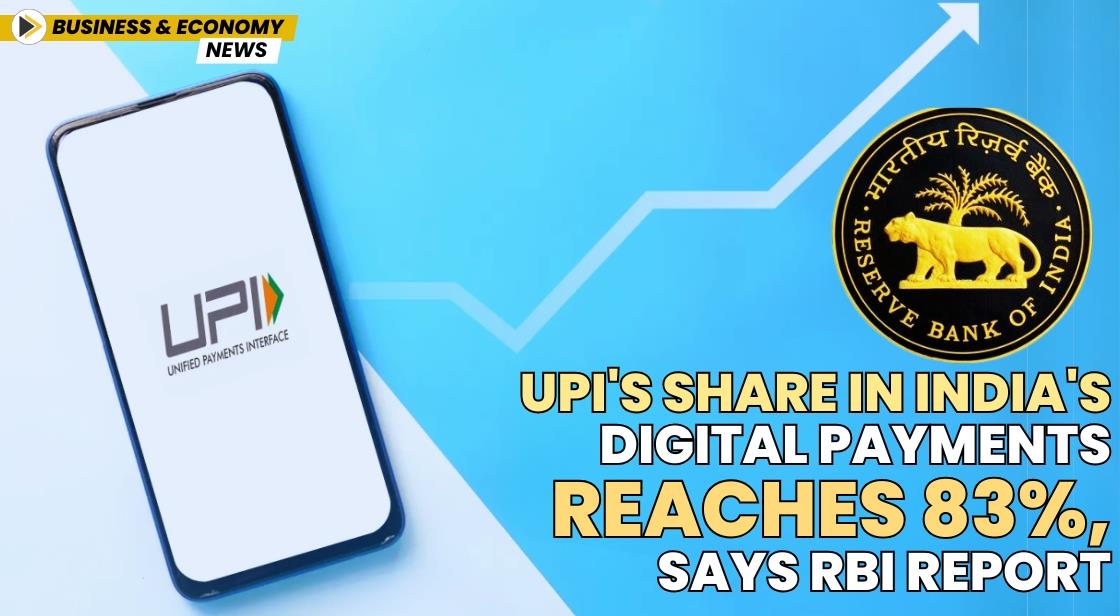UPI's Share in India's Digital Payments Reaches 83%, Says RBI Report

News Synopsis
The Unified Payments Interface (UPI) has seen an exceptional rise in its contribution to India’s digital payments sector. From a share of just 34% in 2019, UPI's share has now surged to a staggering 83% in 2024. This growth is remarkable, with a compound annual growth rate (CAGR) of 74% over the last five years, according to the Reserve Bank of India (RBI) report on the country’s payment systems.
Decline of Other Payment Systems
While UPI's dominance continues to grow, the share of other traditional payment systems has sharply declined. Systems like Real Time Gross Settlement (RTGS), National Electronic Funds Transfer (NEFT), Immediate Payment Service (IMPS), and credit and debit cards saw their combined share in digital payments fall from 66% to just 17% during the same period. This shift highlights the increasing reliance on UPI for daily transactions.
UPI's Role in Boosting Digital Payments
UPI's exponential growth has been the primary driver behind India's digital payments revolution. The ease of use, secure transactions, and real-time payment capabilities have made UPI the preferred choice for both individuals and businesses. As the report outlines, the volume of UPI transactions increased from 375 crore in 2018 to 17,221 crore in 2024. Simultaneously, the total value of transactions surged from ₹5.86 lakh crore in 2018 to ₹246.83 lakh crore in 2024, reflecting a massive increase in both the volume and value of UPI transactions.
UPI’s Growth: A Breakdown of Transaction Volumes and Values
In terms of growth, UPI saw a phenomenal compound annual growth rate (CAGR) of 89.3% in volume and 86.5% in value over the past five years. The surge in transaction volume and value has been unprecedented, and UPI has become integral to daily financial activities across India.
P2P and P2M Transactions: Different Growth Trends
Both Person-to-Person (P2P) and Person-to-Merchant (P2M) transactions are driving UPI's growth. However, there has been a shift in trends: since 2023, the volume of P2M transactions has surpassed P2P transactions. Despite this, in terms of value, P2P transactions continue to lead P2M transactions.
For lower-value transactions, UPI P2M has shown a strong growth trajectory, with a CAGR of 99% for transactions under ₹500 from 2019 to 2024. On the other hand, UPI P2P transactions grew at a slower pace of 56% during the same period. For higher-value transactions exceeding ₹2,000, UPI P2M saw an impressive growth of 109% in the same period, whereas UPI P2P grew at 57%.
UPI Lite: A New Milestone
In December 2024, UPI Lite, a payment method introduced by the National Payments Corporation of India (NPCI), recorded 2.04 million transactions daily, amounting to ₹20.02 crore. This method is aimed at facilitating low-value transactions. UPI Lite has proven highly successful, particularly after Paytm and PhonePe introduced it in early 2023. The RBI report observed a consistent increase in UPI Lite’s transaction volumes and values, showcasing its growing popularity.
UPI's Global Significance
The RBI’s report also highlights the global significance of UPI in the digital payments ecosystem. India’s approach to UPI has positioned it as a global leader in providing digital payment solutions, emphasizing the system as a "public good." This approach is being recognized worldwide and is expected to serve as a model for other economies at various stages of development. The democratic nature of UPI’s design, which includes low-value transactions and penetration into previously underserved segments, offers valuable lessons for other countries.
Conclusion: UPI's Revolutionary Impact on Digital Payments
UPI’s rise in India has been nothing short of revolutionary. The system has democratized access to digital payments and is now an integral part of the nation’s financial infrastructure. With UPI continuing to grow and expand, it is expected to drive further advancements in India’s digital payments landscape while serving as an example for the world.
You May Like









